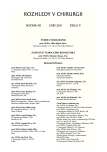Percutaneous Treatment of Symptomatic Massive Bile Ducts Stones after Previous Surgery with Biliodigestive Anastomosis – Report of Three Cases
Authors:
R. Janoušek; T. Daněk *; P. Vyhnálek **; J. Hájek ***
Authors‘ workplace:
Základna radiodiagnostiky a intervenční radiologie, Institut klinické a experimentální medicíny, Praha
; Chirurgická klinika, Pardubická krajská nemocnice a. s., Pardubice
*; Interní klinika, Pardubická krajská nemocnice a. s., Pardubice
**; Radiodiagnostické oddělení, Pardubická krajská nemocnice a. s., Pardubice
***
Published in:
Rozhl. Chir., 2011, roč. 90, č. 9, s. 508-511.
Category:
Monothematic special - Original
Overview
Purpose:
Presentation of our own experience with percutaneous treatment of symptomatic bile-duct stones like late complication in patients with biliodigestive anastomosis.
Method:
Three symptomatic female patients with biliodigestive anastomosis and acutely symptomatic with proven bile-duct stones above anastomosis were treated with initial percutaneous transhepatic drainage and later via percutaneous route using of endoscopic lithotryptor with special technique.
Results:
All procedures were successful without complication, the patients are free of biliary symptoms in the long term.
Conclusion:
Percutaneous removal of bile-duct stones in patients with biliodigestive anastomosis is safe and effective method which can be used as an alternative to surgery.
Key words:
biliodigestive anastomosis – bile duct stones – biliary lithotripsy – percutaneous transhepatic cholangiografy and drainage
Sources
1. Miletic, D., Uravic, M., Mazur-Brbac, M., et al. Role of magnetic resonance cholangiography in the diagnosis of bile duct lithiasis. World. J. Surg., 2006; 30 : 1705–1712.
2. Hatzidakis, A., Krokidis, M., Gourtsoyiannis, N. Percutaneous removal of biliary calculi. Cardiovasc. Interv. Radiol., 2009; 32, 1130–1138.
3. Ozcan, N., Erdogan, N., Baskol, M. Common bile duct stones detected after cholecystectomy: advancement into the duodenum via the percutaneous route. Cardiovasc. Interv. Radiol., 2003; 26 : 150–153.
4. Hazey, J. W., McCreary, M., Guy, G., Melvin, W. S. Efficacy of percutaneous treatment of biliary tract calculi using the holmium: YAG laser. Surg. Endosc., 2007; 21 : 1180–1183.
5. Bonnel, D. H., Liquory, C. E., Corund, F. E., Lefebvr, J. F. P. Common bile duct and intrahepatic stones: results of transhepatic electrohydraulic lithotripsy in 50 patients. Radiology, 1991; 180 : 345–348.
6. Gamal, E. M, Szabó, A., Szüle, E., et al. Percutaneous video choledochoscopic treatment of retained biliary stones via dilated T-tube tract. Surg. Endosc., 2001; 15 : 473–476.
7. Maruyama, T., Mori, A., Tatebe, H. et al. Percutaneous transhepatic cholangioscopic lithotomy of a common bile duct stone through the gallbladder route. Intern. Med., 2007; 46 : 1481–1482.
8. Perry, L. J., Stokes, K. R., Lewis, W. D., et al. Biliary intervention by means of percutaneous puncture of antecolic jejunal loop. Radiology, 1995; 195 : 163–167.
9. Tazuma, S. Epidemiology, pathogenesis and classification of biliary stones (common bile duct and intrahepatic). Best Practice§ Research Clinic. Gastroenterol., 2006; 20 : 1075–1083.
10. Harbin, W. P., Mueller, P. R., Ferrucci, J. T. Transhepatic cholangiography complications and use patterns of the fine needle technique. A multi-institution survey. Radiology, 1980; 135 : 15–22.
11. McNicholas, M. M. J., Lee, M. J., Dawson, S. L., Mueller, P. R. Complications of percutaneous biliary drainage and stricture dilatation. Semin. Interv. Radiol., 1994; 11 : 242–253.
12. Akiyama, H., Okazaki, T., Takashima, I., et al. Percutaneous treatments of biliary diseases. Radiology, 1990; 176 : 25–30.
13. Köcher, M., Černá, M., Havlík, R., et al. Percutaneous treatment of benign bile duct strictures. Eur. J. Rad., 2007; 62 : 170–174.
14. Peregrin, J. H., Köcher, M. Intervence u benigních biliárních lézí. Abstrakt CSIR 2010, Ces. Rad., 2010; 64 : 171.
15. Köcher,M., Thomas, P., Peregrin, J. H., et al. Tlakový perfuzní test. Abstrakt CSIR 2010, Ces. Rad., 2010; 64 : 171–172.
Labels
Surgery Orthopaedics Trauma surgeryArticle was published in
Perspectives in Surgery

2011 Issue 9
Most read in this issue
- Pancreatic Trauma
- Incisional Hernia Following Laparoscopy, Complicated by Perforated Gangrenic Appendicitis – A Case Review
- A Rare Cause of Acute Abdomen
- Thrombolytic Therapy of Acute Peripheral Arterial Occlusions of Limb Arteries
